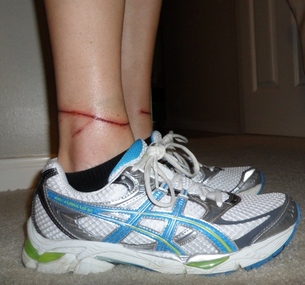Retractable Leashes: The Risks & Dangers of Variable Length Dog Leads
The Dangers of Retractable Dog Leashes
“A retractable leash is not so much a leash as it is a length of thin cord wound around a spring-loaded device housed inside a plastic handle. The handles of most retractable leashes are designed to fit comfortably in a human hand. A button on the handle controls how much of the cord is extended.
Retractable leashes are popular primarily because they aren’t as confining as regular leashes, allowing dogs more freedom to sniff and poke around on walks. But unfortunately, there are many downsides to this type of leash.” – Veterinarian Karen Becker DVM


10 Reasons Not to Use a Retractable Leash
1. The length of retractable leashes, some of which can extend up to 26 feet, allows dogs to get far enough away from their humans that a situation can quickly turn dangerous. A dog on a retractable leash is often able to run into the middle of the street, for example, or make uninvited contact with other dogs or people.
2. In the above scenario, or one in which your pet is being approached by an aggressive dog, it is nearly impossible to get control of the situation if the need arises. It’s much easier to regain control of – or protect — a dog at the end of a six-foot standard flat leash than it is if he’s 20 or so feet away at the end of what amounts to a thin string.
3. The thin cord of a retractable leash can break – especially when a powerful dog is on the other end of it. If a strong, good-sized dog takes off at full speed, the cord can snap. Not only can that put the dog and whatever he may be chasing in danger, but also the cord can snap back and injure the human at the other end.
4. If a dog walker gets tangled up in the cord of a retractable leash, or grabs it in an attempt to reel in their dog, it can result in severe burns and cuts (often with unsightly scarring) to arms and legs, and even amputation of fingers. In addition, many people have been pulled right off their feet by a dog that reaches the end of the leash and keeps going. This can result in bruises, “road rash,” broken bones, and worse.
5. Dogs receive terrible injuries as a result of the sudden jerk on their neck that occurs when they run out the leash, including neck wounds, lacerated tracheas, and injuries to the spine.
6. Retractable leashes allow dogs more freedom to pull at the end of them, which can look like aggression to another dog who may decide to “fight back.”
7. The handles of retractable leashes are bulky and can be easily pulled out of human hands, resulting in a runaway dog.
8. Along those same lines, many dogs – especially fearful ones – are terrorized by the sound of a dropped retractable leash handle and may take off running, which is dangerous enough. To make matters worse, the object of the poor dog’s fear is then “chasing” her, and if the leash is retracting as she runs, the handle is gaining ground on her – she can’t escape it.
Even if this scenario ultimately ends without physical harm to the dog (or anyone else), it can create lingering fear in the dog not only of leashes, but also of being walked.
9. Retractable leashes, like most retractable devices, have a tendency to malfunction over time, either refusing to extend, refusing to retract, or unspooling at will.
10. Retractable leashes are an especially bad idea for dogs that haven’t been trained to walk politely on a regular leash. By their very nature, retractables train dogs to pull while on leash, because they learn that pulling extends the lead.
Serious Injuries to Dogs
Veterinarians report serious injuries to dogs from retractable leashes, such as:
- tail injuries resulting in amputation
- lacerations down to the bone
- injuries to tendons
- torn skin (on inner thighs from the leash going under the dog)
- eye injuries
- burns to the skin
- pet injuries and fatalities from dog fights and bites resulting from the use of a flexi-style leash
Flexi-style leashes send mixed (poor) communication signals to the dog. There is always tension on a retractable leash. The dog is aware of this, and this can have negative consequences, including excessive pulling and the dog being in a constant state of arousal, due to the constant tension on the leash.
Even world-renowned dog training expert Cesar Millan has something to say about the subject: “Retractable leads have a purpose, and it’s very specific. They were originally designed for certain types of tracking and recall training with dogs. If you don’t know what those are, then you have no reason to own or use a retractable lead. You should never use such a lead for just walking your dog.”
Are Retractable Leashes BANNED in Your City?
What many dog owners don’t know is that their city’s leash laws may actually ban or restrict the use of retractable leashes. So, should your leash or leashed dog cause injury to others, you may find yourself on the wrong side of the law.
In cities allowing these types of leashes, there might also be a restriction of allowing your pet to roam no farther than 6-8 feet from you while using any kind of leash. Be sure to check your city’s leash laws before you venture out with a dangerous leash attached to your dog.
Multnomah County Leash Laws
In Multnomah County, dogs are not permitted to roam at large without a leash. The leash ordinance requires dogs to be on a leash no longer than 8 feet on all city land. If you do not properly leash and control your dogs, or if you allow your dogs to run at large, you could face hefty fines.
Dogs must be on a leash of a length that will allow for direct control of the dog by the handler in control of the dog. A retractable leash doesn’t allow for direct control of the dog attached to it.
“But MY Dog is Well-Behaved on His Leash!”
If your dog is well-trained, gentle-mannered, and smart enough to master a regular leash and a retractable leash without being confused, you could be one of the rare guardians that can walk your pooch on any kind of leash without increasing risks to either one of you.
Do you use a retractable leash on your pet? Please consider switching to one of the many different kinds of leashes available online or at your local stores.
Resources
Top 10 list originally appeared on healthypets.mercola.com and was written by integrative wellness veterinarian Dr. Karen Becker


